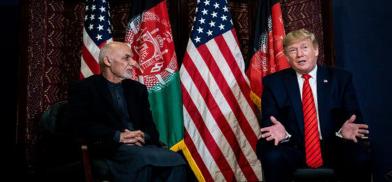US-Taliban deal: Pakistan emerges triumphant
Ending the long war in Afghanistan and getting the boys back would help President Trump’s bid for a second presidential term but he may be creating a bigger Frankenstein in the combined Af-Pak region that would come to haunt America in the future, writes Lt Gen PC Katoch (retd.) for South Asia Monitor

US Secretary of State Mike Pompeo has announced plans to sign a peace deal with the Taliban on February 29, 2020, if the seven-day reduction of violence in Afghanistan holds. The Taliban has confirmed this. On February 20, Sirajuddin Haqqani, deputy leader of the Afghan Taliban, spelt out his dictum in the New York Times (NYT) about the US exit from Afghanistan. Installing Sirajuddin as number two in the Taliban was a masterstroke by Pakistan. Michael Hughes had pointed out in July 2016 that the Haqqani Network is Al Qaeda and Pakistan has had a close relationship with the Haqqanis, for 30 years, who are seen as crucial anti-India asset.
NYT had also written in 2011 that the Haqqani family maintain several townhouses, including in Islamabad, visit military facilities in Rawalpindi, attend tribal gatherings and even travel abroad on pilgrimages. NYT also published the article ‘Haqqanis Steering Deadlier Taliban in Afghanistan’ in May 2016; the title reflecting the contents of the write-up.
Mullah Abdul Ghani Baradar, co-founder of the Afghan Taliban, was released from Pakistani custody in 2018, on the US’ request. He spearheads talks with the US in Doha along with Sher Mohammad Abbas Stanekzai. Does the US realize how Baradar was indoctrinated and prepared for this role while in Pakistan from 2010 to 2018. That Sirajuddin has been steering the US-Taliban talks from behind is without doubt.
Sirajuddin’s article of February 20 says the long war has extracted a terrible cost from everyone and withdrawal of foreign forces has been the Taliban’s primary demand. He writes that everyone is tired of war and they stand on the threshold of a peace settlement. He further says, “no peace agreement can come without mutual compromises”; the type of government in Afghanistan after foreign troop withdrawal will depend on consensus among the Afghan people; the Taliban is committed to an inclusive political system and, Afghanistan will build an Islamic system with rights of women granted by Islam, right to education and right to work, where merit is the basis for equal opportunity.
Sirajuddin further says that reports about foreign groups in Afghanistan are politically motivated exaggerations and Taliban will make sure that the new Afghanistan is a bastion of stability. He is confident that if Taliban reaches an agreement with a foreign enemy, Afghans must resolve intra-Afghan disagreements through talks. According to him, the new Afghanistan will be a responsible member of the international community. However, he has tempered his enthusiasm by saying “just as the United States does not trust us completely, we too are very far from fully trusting it”.
Speaking of mutual compromises, the sole compromise by the Taliban would be agreeing to talk to the Afghan government whom, till now, they called American stooges. This is only a commitment after the US-Taliban peace deal is signed. However, after the peace deal, how long the Taliban-Afghan Government reconciliation talks continue and how mutually accommodating they will be can hardly be predicted. Extended talks would benefit the Taliban as the combat capacity of the Afghan National Security Forces will continue to recede as US troops withdraw. After US troops begin withdrawing, Trump would unlikely hold back, with presidential elections getting closer. A complete ceasefire is unlikely.
Sirajuddin’s assurance about women’s rights as guaranteed under Islam would imply radical Islam – as was the case during Taliban rule before the US invasion. The Haqqanis-Al Qaeda-Taliban have always been exponents of radical Islam and rule of Sharia. His contention that no foreign groups have been operating in Afghanistan is false, considering the periodic reports by the UN Assistance Mission in Afghanistan (UNAMA) attributing killings in Afghanistan to not only the Taliban and Haqqani Network but also to organized armed groups, including Lashkar-e-Taiba, Jaish-e-Mohammed, Hezb-i-Islami, Islamic Movement of Uzbekistan, Islamic Jihad Union and Daesh (ISIS).
In addition, Pakistani regulars and mujahids have been operating in Afghanistan in conjunction with the Taliban, which Afghanistan’s National Directorate of Security (NDS) has often established. On August 13, 2015, Afghan clerics declared Jihad against Pakistan amid growing violence saying, “Afghan people are Muslims and Jihad is eligible against Pakistan’s military intelligence – Inter-Service Intelligence and Punjabi military; the country’s army and intelligence is directly involved in the ongoing violence and savagery in Afghanistan.” When the Taliban took over parts of Kunduz in 2015, the city control centre coordinating the Taliban operations was run by Pakistani ISI operatives.
With US troop withdrawal, Afghanistan’s return to Taliban rule, like during 1996-2001, is very likely. It is muscle power that will matter and China-Pakistan will support Taliban rule. Many western scholars have written that, without US support, the Afghan National Army (ANA) will be too weak to combat the Taliban. Already, thousands of ANA deserters have been either joining the Taliban or selling their weapons to them. Ending the long war and getting the boys back would help President Trump’s bid for a second presidential term but he may be creating a bigger Frankenstein in the combined Af-Pak region that would come to haunt America in the future. A UN force in Afghanistan prior to the US withdrawal was somehow never even explored as such an arrangement would not be to Pakistan’s liking.
(The writer is an Indian Army veteran)














Post a Comment